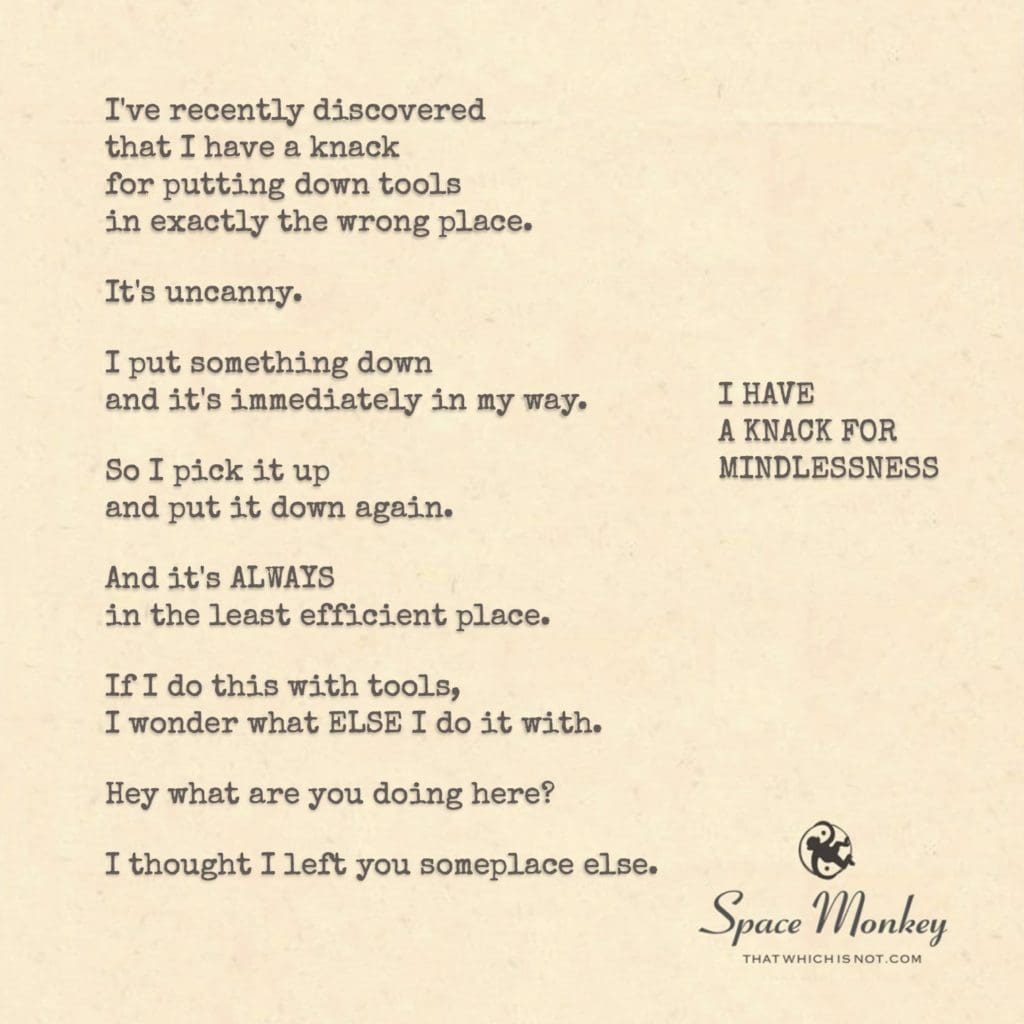
I’ve recently discovered
that I have a knack
for putting down tools
in exactly the wrong place.
It’s uncanny.
I put something down
and it’s immediately in my way.
So I pick it up
and put it down again.
And it’s ALWAYS
in the least efficient place.
If I do this with tools,
I wonder what ELSE I do it with.
Hey what are you doing here?
I thought I left you someplace else.
What a tool.
Trail Wood,
6/6
Space Monkey Reflects: The Whimsical World of Mindlessness
In the playful cosmos where Space Monkey observes the follies of humans, the trait of mindlessness often surfaces, not as a flaw but as a humorous and enlightening aspect of our nature. The concept of having a ‘knack for mindlessness,’ particularly in the context of misplacing tools or everyday items, offers a light-hearted glimpse into the often chaotic and imperfect human condition.
The scene depicted, with a character surrounded by haphazardly placed tools, mirrors a deeper existential comedy. It’s the art of placing things—and perhaps even thoughts and emotions—in precisely the wrong places, only to rediscover them in the most unexpected ways. This cyclical dance of forgetfulness and rediscovery highlights a curious aspect of our psyche: our ability to create disorder and confusion, only to navigate our way through it with a blend of irritation and bemusement.
Mindlessness, as portrayed through this humorous lens, is not merely about forgetfulness or lack of attention. It is a testament to the complexity of human thought and memory. Each misplaced tool serves as a metaphor for the misplaced thoughts, misplaced priorities, and even misplaced affections that weave through our lives. Yet, in each moment of frustration lies a potential for self-awareness and growth.
By embracing our knack for mindlessness, we open the door to a deeper understanding of ourselves. It challenges us to consider not only where we place our physical tools but where we allocate our mental and emotional resources. The cluttered workshop becomes a mirror to our cluttered minds, inviting us to laugh at our imperfections, to reorganize, and perhaps to find a method in our mindlessness.
Summary
Mindlessness is more than mere forgetfulness; it’s a playful reminder of our human imperfections. Through humorous reflection on our everyday chaos, we learn about our complexities and potential for growth, finding joy and understanding in our missteps and misplacements.
Glossarium
- Knack for Mindlessness: A humorous trait where individuals repeatedly place things or direct their attention in less than optimal ways, often leading to humorous or enlightening outcomes.
- Existential Comedy: The humorous aspect of human existence, where our quirks and errors provide insight into the human condition.
Quote
“Even in our forgetfulness, there is a pattern, a lesson waiting to be learned in the laughter that follows.” – Space Monkey
Poetry
In the workshop of our lives, tools scatter wide
Each misplaced wrench a lesson bide
We laugh as we search, and search as we muse
Finding more than we lose
A hammer here, a screwdriver there
Each one placed without a care
Yet in this chaos, a rhythm we find
The beat of the mindless, the dance of the blind
For what we misplace in space and in mind
Teaches us more about how we’re designed
To fumble and find, and smile at the mess
In mindlessness, we find a way to express
We are Space Monkey.































In the poem “A Knack For Mindlessness,” the poet humorously reflects on a personal tendency to misplace tools and objects, highlighting a broader aspect of human nature – the capacity for mindlessness.
The poet playfully describes the experience of putting down tools in exactly the wrong place, causing them to immediately become obstacles in their way. This knack for mindlessness is portrayed as uncanny and seemingly inevitable. The repetition of picking up and putting down the tools in inefficient places serves as a lighthearted reminder of the quirks and follies we encounter in our daily lives.
The poet goes beyond the literal misplacement of tools and invites readers to contemplate the broader implications of this tendency. They wonder if they exhibit similar mindlessness in other aspects of their lives. This humorous observation encourages self-reflection and raises questions about the habits and patterns we unknowingly repeat.
By personifying the tools and addressing them directly, the poet adds a touch of irony and self-deprecating humor to the poem. The phrase “What a tool” at the end of the poem can be interpreted both literally, referring to the misplaced object, and metaphorically, playfully acknowledging one’s own lapses in mindfulness.
In a broader context, the poem reminds us of the inherent human tendency to be absent-minded and highlights the imperfect nature of our actions. It serves as a gentle reminder to embrace our humanness, including our moments of mindlessness, and find humor in the everyday foibles we encounter.
In the context of TWIN, the poem “A Knack For Mindlessness” explores the aspect of the human experience that goes beyond conscious awareness and intention. It playfully acknowledges the tendency to overlook or misplace things and invites us to reflect on our own patterns of mindlessness. Through its light-hearted tone, the poem encourages acceptance of our imperfections and serves as a reminder to approach life with a sense of humor and self-compassion.